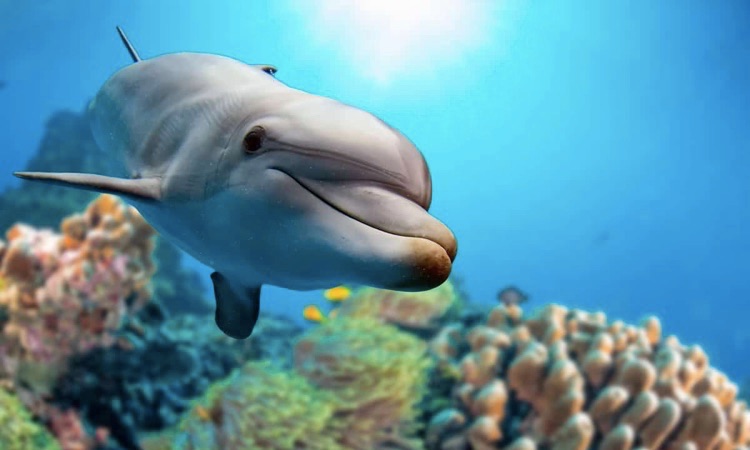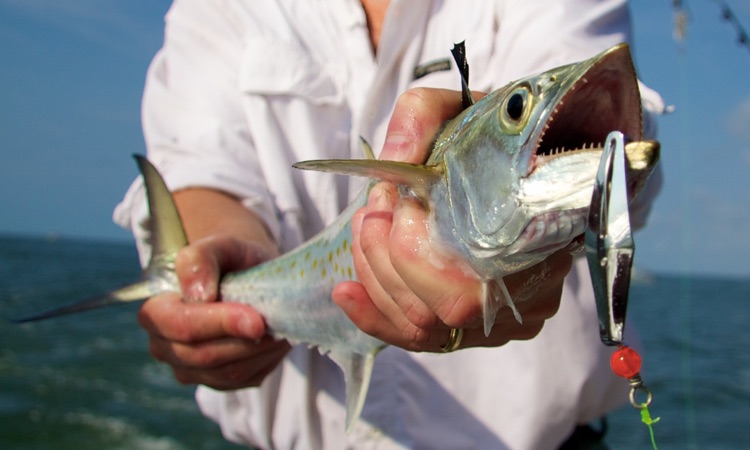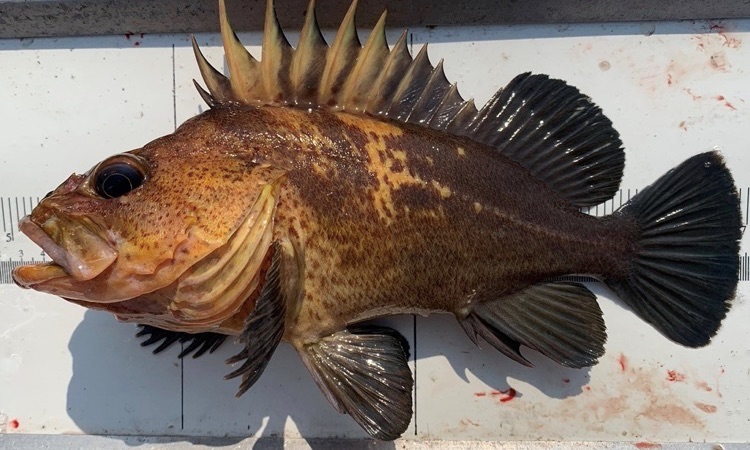Glowing with an other-worldly luminescence, jellyfish float through the sea like alien wonders of nature.
They have a mesmerizing beauty, shaped in a bell-like form that almost seems too perfect to be real. People often ask, ‘what do jellyfish eat?’ and ‘how do jellyfish eat?’
Without doubt, these creatures captivate us as one of the most incredible spectacles on Earth. So we feel an obligation to answer the above questions. Without further ado, here are the answers to these questions.
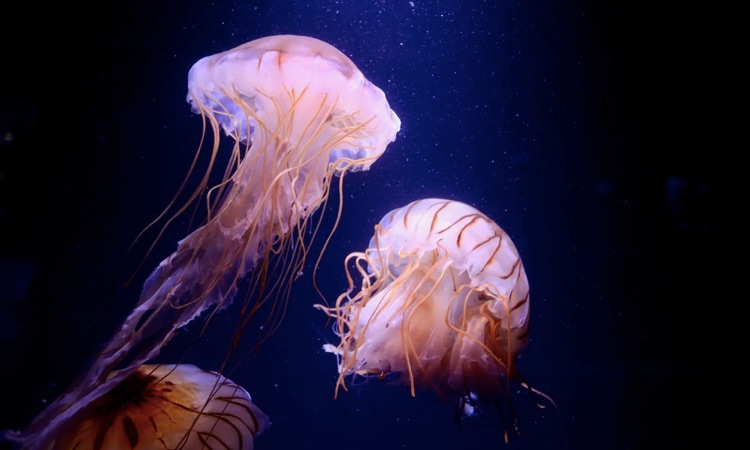
What do Jellyfish Eat?
The jellyfish has an extensive and multifaceted diet, based on the species. It mainly consists of plankton, crustaceans, plants, small fish (including both egg and larval stages), as well as other jellyfish.
The majority of jellyfish species maintain an exclusively carnivorous diet. Think of a large jellyfish savoring the flesh of a lobster or crab.
But then there are those rare exceptions that distinguish themselves from others. Like the spotted jellyfish which cultivates algae inside its stomach and nourishes itself with photosynthesis!
No matter their eating habits, jellyfish are notorious for their insatiable hunger. At times they can congregate in massive groups of millions known as blooms that ingest so much food, they deplete entire fisheries. Not leaving a single morsel left for humans to fish out!
Climate change, unfortunately, is expected to amplify the frequency of toxic algal blooms in our oceans, further decimating vulnerable ecosystems.
How do Jellyfish Eat?
Have you ever wondered how jellyfish capture and consume their prey? Well, the answer to that depends on what stage of life they are in. What most people don’t comprehend is that jellyfish undergo a remarkable transformation during each part of its four-stage lifecycle.
Jellyfish are truly extraordinary molluscs, capable of employing a brilliant evolutionary strategy. They alternate between sexual and asexual reproduction at various stages in their lives.
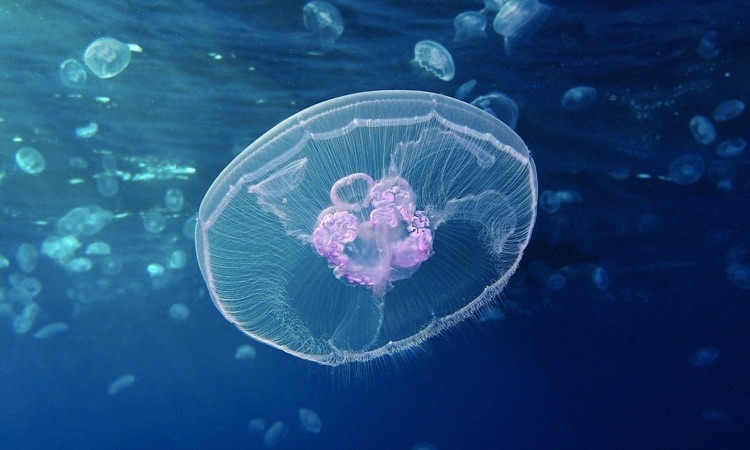
In the Early Lifecycle
Beginning with the initial stage of a jellyfish’s life cycle, sperm and egg from its parents are combined to create the larva. When it locates an appropriate surface, this larva will rest in order to evolve into a stationary polyp. After some time has elapsed, multiple clone-like ephyrae will emerge, ready to swim freely throughout their environment.
The polyp stage is usually the longest and most prolonged of all four life stages, staying in this form for some years until optimum conditions arise. Then, it will proceed to develop into a medusa adult with only one purpose. To reproduce before dissipating back into its larval forms. The remaining transitional phases then repeat themselves cyclically ensuring the species’ preservation within their marine habitats.
The polyp is an immobile hunter, with a perfected digestive system rooted to its substrate. Its tentacles grasp at whatever organic matter or small creatures that drift by, providing sustenance and keeping it alive. It’s the ultimate example of capturing prey without having to move!
When the jellyfish reaches its medusa form, it can move around with ease. They effortlessly drift through the water, propelled by either a current or their own strength. This lack of effort when searching for food is likely due to its limited neurological and muscular system that prevents them from out-maneuvering prey or swimming faster than them.
At the Point of Maturity
To feed, jellyfish unfurl their long tentacles far and wide – some species (like the lion’s mane) can reach a dramatic 100 feet! These lengthy strands are lined with thousands of stinging cells which immobilize prey as they pass by. Painful to humans, these lethal tentacles are integral to jellyfish digestion.
With explosive pressure of 2,000 pounds per square inch, jellyfish sting their victims on contact. For some species, the prick can cause excruciating pain and even be fatal to humans. However these cases are typically a result of defensive behavior from the jellyfish rather than intentional malice.
Jellyfish possess the incredible capability to draw sustenance towards their tentacles with only the force of swimming. This conserves energy, allowing them to swim about effortlessly in search for food.
An intriguing twist to this narrative is that a number of jellyfish species partake in symbiotic relationships with other living creatures. Symbiosis, which is essentially what we call this alliance between two organisms occupying the same space, can be advantageous for both sides if managed correctly.
A Symbiotic Relationship
This means that some smaller creatures and juvenile fish dwell near the center of jellyfish, either resistant to its toxin or managing to evade its tentacles, in order to shield themselves from common predators.
What does the jellyfish gain from its symbiotic relationship? It has been hypothesized that these species may act as a decoy, enticing prey to come within reach of the jellyfish and providing it with an easy meal.
Unfortunately, not all of these relationships end amicably; there have been cases in which the jellyfish decided to devour its guest instead.
It’s a gamble worth taking for the more diminutive creatures, as their chances of survival are far greater when they take shelter inside the jellyfish.
The aptly named cannonball jellyfish has an advantageous relationship with at least 10 marine species, including juvenile longnose spider crabs who reside within its bell (it is not obvious what advantages this provides to the jellyfish; it could be merely one-sided).
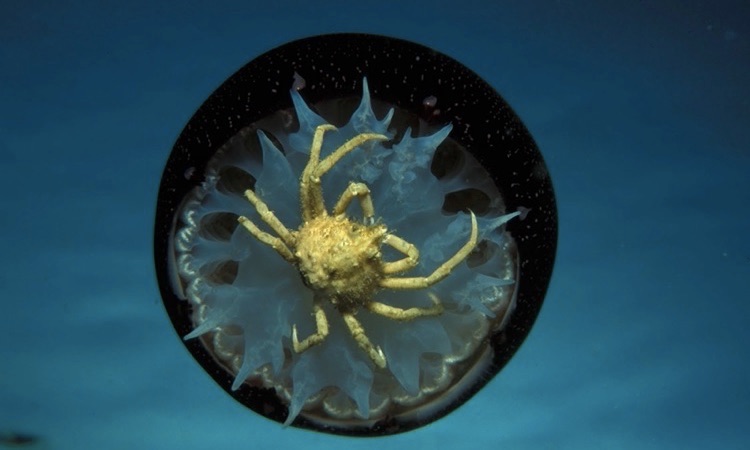
How is Jellyfish Food Digested?
Although they appear quite basic in their anatomy, jellyfish possess the same digestive organs as any other animal.
For certain species of these creatures, a set of oral arms located on the underside of their bells helps them capture and transport food to its mouth – even after it has been paralyzed or killed by the creature itself.
These maneuverable tentacles bear many striking resemblances. At the base of the bell lies a small aperture that serves as both an entry and exit point. While also functioning as a mouth, anus, and general opening for water to move through its body.
The jellyfish anatomy displays its simplicity in the direct connection between their mouth and stomach. No throat or any other organ exists as a middleman. Instead, merely a small entry bridges the two together.
Its Simple Digestive System
Despite its absence of organs like livers, pancreases, and intestines which are vital for the production of essential chemicals and absorption of nutrients in other creatures, jellyfish possess a remarkably straightforward digestive system.
Instead, jellyfish possess a large cavity that produces all the requisite components for breaking down food. As opposed to other creatures, jellyfish lack any sort of circulatory system; consequently, nutrients disperse naturally into their surrounding environment across the entirety of its body.
After the jellyfish is finished consuming its meals, it swiftly ejects out undigested waste through its mouth. This process of expelling and eating again is quick and efficient, not allowing a second meal to be ingested until the previous one has been released from the body.
Boasting a 600 million year history, the jellyfish is an impressive example of how creatures can survive and thrive with little more than basic functions and behaviors.
This simplicity is likely due to its lack specialized organs such as intestines or livers that are so essential in the evolution of animals further up on the food chain.
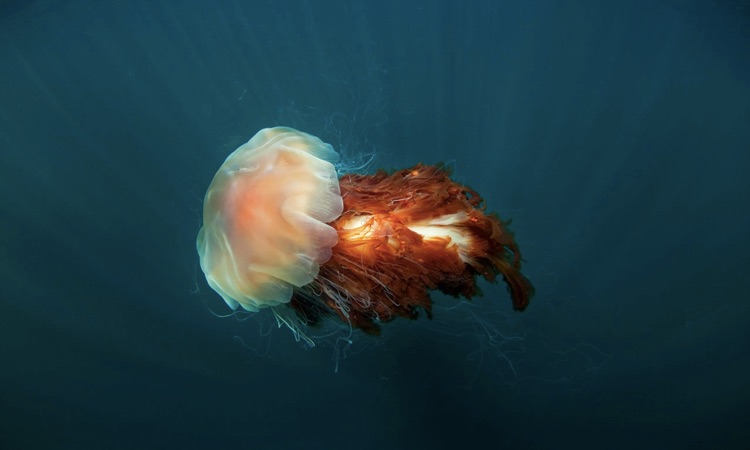
History of Jellyfish
Approximately 600 million years ago, the first ever jellyfish took form. Unfortunately, their fragile structure does not lend itself to fossilization; thus this approximate date is used.
These aquatic beings made up of more than 95% water were one of the original multi-organ animals that lived on Earth and had fairly simple bodies without respiratory or circulatory systems.
Only basic digestive and neurological features present. In contrast to these creatures, human beings are composed of just 60%, making them less susceptible to dehydration.
Jellyfish have come a long way since their initial evolution. In the beginning, they could only consume basic organisms in water.Bbut now, they have access to an immense array of aquatic animals and plants!
Not only does this provide them with much more nutrition for growth, it can also change the coloration of jellyfish from pink to purple or red due to various pigments found in different types of food.
Although jellyfish are seemingly uncomplicated, they’re truly some of the swiftest swimmers in the sea, primarily because such a small part of their body is used for movement. With each undulation of their bell-shaped bodies, jets of water propel them forward towards wherever they desire to go.
Keeping Jellyfish in an Aquarium
You can even maintain jellyfish in your own home aquarium. However, a few modifications must be made to the tank so their delicate bodies remain safe from any filters.
In order for jellyfish to properly thrive, their environment must be motionless. Additionally, other fish should not be added to the aquarium so that they don’t become a victim of jellyfish stings.
In Summary
Despite their distinct differences, jellyfish and other animals share similar characteristics such as a symmetrical body plan and capability to use oxygen. All existing types of jellyfish along with corals and sea anemones belong to the same phylum called Cnidaria – just like all known vertebrates occupy one single phylum.
Adult jellyfish boast an array of sizes, colors, and tentacles that all stem from a symmetrical bell-shaped body. In fact, these creatures can be located in almost any marine environment on the globe.
However some species have adapted to surviving solely in freshwater habitats too. Don’t panic! The small size of the tentacles on these freshwater jellyfish make them completely harmless to humans.

